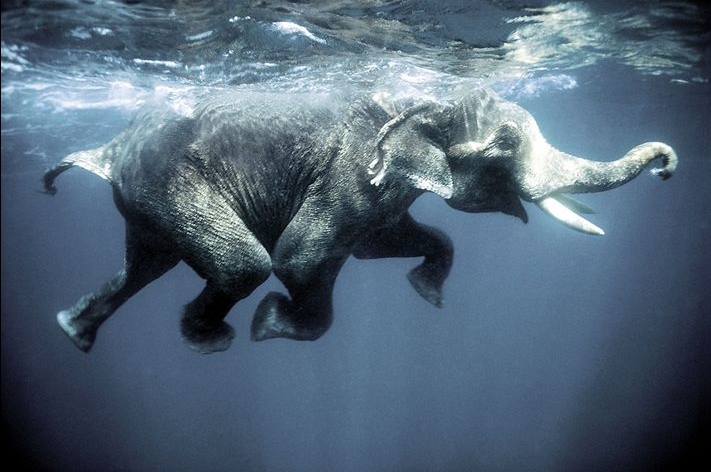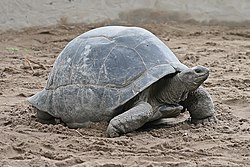I prepared baked chicken for supper 2 weeks ago. American chickens are nice and fat but for some dishes they are too fat. I removed the skin from the chicken pieces before rolling them in cracker crumbs and black pepper. This reduces the unwanted grease that nutritionists claim clog our arteries. However, I hate wasting food, so I boiled the chicken skins and put some of them with the broth in a bowl for the cat. I placed the bowl on the back step. A few minutes later, I looked out the window to see if the cat was enjoying his warm treat on such a frosty night. Instead, an unidentifiable gray object was over the bowl. I turned on the light and saw an opossum. I ran to fetch my camera, but when I opened the door, the creature scurried away quickly, a piece of chicken skin dangling from its mouth. Later, the possum returned and I took a decent photograph of it.
I discovered this opossum eating food I put on the back step for my cat.
The feral cat that I tamed (see:http://markgelbart.wordpress.com/2014/06/24/mr-claw/) used to eat every speck of food I placed outside. But now that he realizes I’m going to feed him everyday, he doesn’t devour every bit at once. There’s no telling how often that opossum has been scavenging cat food. Possums are quite common in my neighborhood. Several weeks ago, I saw a road-killed possum down the street that a flock of vultures made disappear in less time than it took me to jog 3 miles.
The Virginia opossum (Didelphis virginiana) is an amazing survivor. Opossum remains are found in just about every Pleistocene-aged fossil site in Georgia, and they are still abundant today. Their rapid rate of reproduction is their most important survival attribute. They become sexually mature at 6 months, and their gestation period is less than 2 weeks. They produce up to 18 young but the females only have 13 nipples. An average of 7 young survive to adulthood. Nevertheless, in about a year’s time 2 opossums can result in roughly a 20 fold increase. When attacked by a large predator, opossums can escape by climbing a tree. Their prehensile tails allow them to hang upside down from branches, giving them a good view of potential threats. If they are unable to make it to a tree when attacked, their nervous system becomes overwhelmed, and they literally shit and faint. The noxious fluid that leaks from their anus makes them unappetizing to predators. Unless a predator is especially hungry, the lack of movement and bad smell will cause them to lose interest. The opossum then recovers and goes on with its business.
Opossums are also omnivorous–another contributing factor to their success as a species. They eat fruit, carrion, insects, worms and grubs, birds and eggs, small mammals, reptiles, and even venomous snakes. They are immune to rattlesnake venom. A recent study found there is an evolutionary arms race between opossums and pit vipers. Scientists discovered opossums have rapidly evolving gene codes for Von Willibrandt’s Factor, an important blood-clotting protein targeted by snake venom. Natural selection has strongly favored those individuals of the opossum population immune to snake venom. Creationists often use “living fossils” such as the opossum as evidence that evolution doesn’t occur. They are wrong. Although the modern Virginia opossum is anatomically identical to the opossum of 3 million years ago, its physiology has evolved considerably. If we could bring an opossum from 2 million years ago to the present, it would likely not be able to survive the bite of a modern day rattlesnake like its modern day descendents can.
The opossum is 1 of the oldest species of North American mammals. Ancestral opossums first evolved about 65 million years ago when the dinosaurs became extinct. This is also the time when the shared ancestry of American opossums and Australian marsupials diverged. These ancestral species of opossums became extinct in North America about 25 million years ago, but they continued to live in South America which at that time had become an island continent. A landbridge emerged 3 million years ago, connecting North and South America, and this is when Virginia opossums moved north. At least 103 species of opossums live in South America, but only 1 evolved the ability to survive in the temperate climates that occur in North America. All the other species are restricted to tropical climates. There are 5 other species of opossums in the Didelphis genus that are closely related to the North American opossum. There are also 4-eyed opossums (they don’t actually have 4 eyes), 14 species of woolly opossums, 20 species of short-tailed oppossums, 56 species of diminutive mouse opossums, and a water opossum well adapted to a semi-aquatic existence.
Reference:
Jansa, Sharon A.; and Robert Voss
“Adaptive Evolution of the Venom-Targeted vWF Protein in Opossums that eat Pit Vipers”
Plos One 6 (6) 2011










































